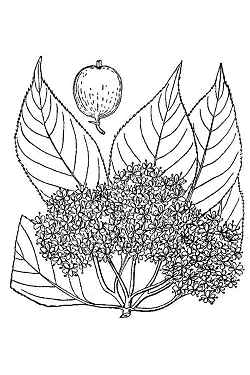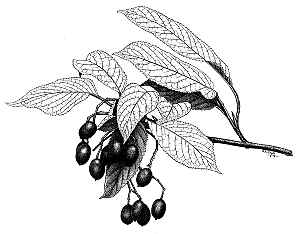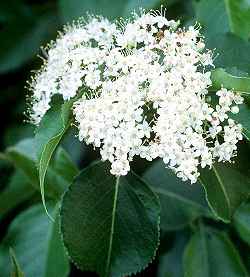Nannyberry, Sheepberry
Scientific Name: Viburnum lentago L.
Synonym: Viburnum Χ vetteri
Family: Caprifoliaceae

Viburnum lentago, Britton, N.L., and A. Brown. 1913. Illustrated flora of the northern states and Canada. Vol. 3: 273. Courtesy of Kentucky Native Plant Society.
Sunset®: 1-9,14-21
USDA: 3-8b
Sun Exposure: Full sun to part shade
Origin: Northeastern North America
Growth Habits: Deciduous large shrub or small tree reaching 15 to 30 feet tall (4.5-9 m), 8 to 12 feet spread (2.4-3.6 m); gray brown bark, scaly when old; shiny dark green, finely serrated leaves, 2.4 to 4 inches long (6-10 cm) with long pointed tip, reddish winged petiole with warty margins
Propagation: Cuttings, seeds, suckers, easy by layering

Viburnum lentago, , U.S.D.A. Forest Service, courtesy of the Hunt Institute

Douglas Ladd. USDA SCS. 1989. Midwest wetland flora: Field office illustrated guide to plant species. Midwest National Technical Center, Lincoln, NE. Courtesy of USDA NRCS Wetland Science Institute.
Blooming Habits:
Tiny, white, flowers, in round topped clusters, 3 to 5 inches in diameter (7.5-12.5 cm), in late spring.
Fruiting Habits:
Edible bluish-black, oval drupes, up to 0.5 inch long (12 mm), on red stems, in drooping clusters, ripening in the fall.
Desert-Tropicals is dedicated to provide gardening advice, gardening ideas, and information about flower of all kind for landscape and collections.We try to check carefully the identification of the plants on the illustrations as well as the other information from the page, but occasionally errors do occur. if you notice anything that needs to be changed please contact us.Thanks.
© 1998-2020 Philippe Faucon, All Rights Reserved.